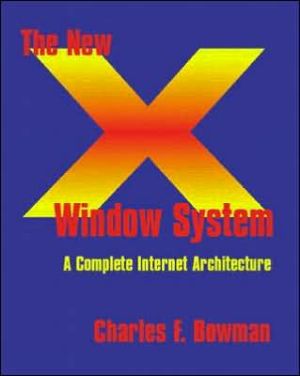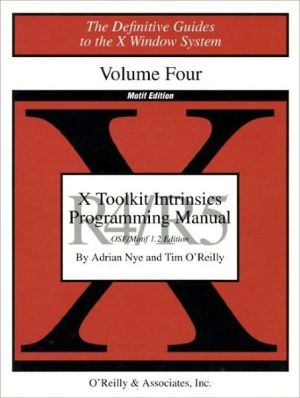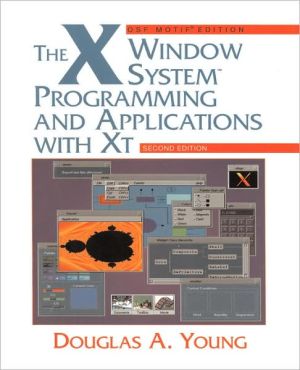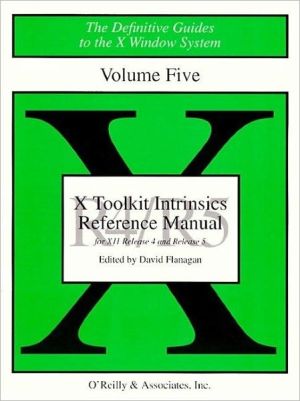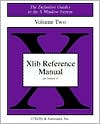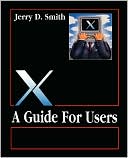The New X Window System: A Complete Internet Architecture
The New X Window System presents complete and authoritative information on X11R6.4, the new X Window technology that enables enterprise systems—both legacy and newly developed—to run over the Internet. Code-named Broadway, this powerful technology holds many advantages for organizations. It enables X applications to move seamlessly from LANs to WANs to the Internet without the need to rewrite or even recompile, saving enterprises many thousands of dollars. Broadway also allows users access to...
Search in google:
The New X Window System presents complete and authoritative information on X11R6.4, the new X Window technology that enables enterprise systems—both legacy and newly developed—to run over the Internet. Code-named Broadway, this powerful technology holds many advantages for organizations. It enables X applications to move seamlessly from LANs to WANs to the Internet without the need to rewrite or even recompile, saving enterprises many thousands of dollars. Broadway also allows users access to enterprise programs from anywhere on the Internet, offers a consistent application interface—whether inside or outside a firewall—and greatly improves the performance of X applications. Geared for architects, designers, developers, and administrators, The New X Window System introduces X11R6.4, highlights its many advantages, and shows how to harness the technology to the greatest advantage. Readers will find a detailed description of the X11R6.4 architecture, its various components, migration, and the administration tasks required to enable an enterprise application to execute remotely via the Internet. The book also offers a comparison of Broadway to other Internet solutions, most notably Java(TM). Specific topics covered include: The rationale behind X11R6.4 and its evolution from earlier X technology Broadway's low-bandwidth X (LBX) technology for enhancing performance X11R6.4 HTTP/HTML extensions Web server and browser administration X11R6.4 security, including access control lists (ACLs) and magic cookies Interoperability with Java and the Microsoft Terminal Server Writtenby a leading authority on X, The New X Window System demonstrates Broadway's complete Internet solution—one that is easily deployed and maximizes an organization's investment in its information technology. Booknews An introduction to X11R6.4, an X Window technology that enables enterprise systems to run over the Internet. Writing for Net architects, designers, developers, and administrators, the author describes X11R6.4 architecture, its various components, migration, and the administrative tasks required to enable an enterprise application to execute remotely via the Internet. A comparison to other Internet solutions, notably Java, is also discussed. Annotation c. Book News, Inc., Portland, OR (booknews.com)
PREFACE: \ The Internet has not only changed the way users interact with computers, it has also revolutionized the way designers and developers construct and deploy software systems. The old, monolithic design rules no longer apply. To capitalize on today's distributed technologies, programmers and system engineers must alter fundamentally their approach to application design.\ That notwithstanding, the advantages provided by the new deployment architectures should not be limited solely to new applications. Rather, information technology (IT) professionals should be able to integrate existing applications into these new design paradigms as well. However, to achieve such a goal, IT professionals require a tool that integrates new designs and applications with existing legacy systems.\ To this end, this book describes X11R6.4-the X Window System's new architecture-as a complete Internet solution. Assigned the code name Broadway, X11R6.4 provides IT mangers and developers a number of important advantages. First, it allows existing enterprise applications to move seamlessly from a local area network to a wide area network to the Internet. This echoes X Window's original design imperative. Specifically, Broadway allows any user to access any application, from anywhere on the Internet. Second, Broadway increases significantly the display performance of existing enterprise applications. For example, Broadway includes several features (most notably low-bandwidth X) that improves the performance of X-based applications. In addition, Broadway provides its users program continuity regardless of location. As a result, application screens and interfaces look the same regardlessof the user's location (either inside or outside the firewall).\ Note that developers gain these advantages without having to rewrite-or even recompile-existing programs. This feature alone will save IT organizations thousands of dollars.\ Why is this important? All organizations have finite IT budgets. Nonetheless, to remain competitive in today's markets, companies must provide their employees with every possible technological advantage. Obviously, every dollar spent porting old applications to new environments is a dollar that is not available for the development of new tools. Broadway maximizes an organization's ability to extend its technological arsenal by minimizing-indeed, eliminating-the cost of reengineering. In addition, Linux (a UNIX variant) is becoming the platform of choice in many IT shops. Thus, native, efficient support for newly developed, distributed X-based applications has become an imperative for many development organizations.\ There is another reason why the new development architectures are important: Development organizations will no longer need to tolerate a one-vendor, one-platform solution. Modern IT solutions comprise an integrated suite of hardware and software components: some purchased, some leased, some developed. Indeed, one of the problems confronting developers new to this environment is managing the overwhelming wealth of choice.\ Who Should Read this Book?\ This book describes X11R6.4 as a complete Internet solution. It discusses its architecture, its major components, and most importantly, its advantages for developing and deploying distributed applications. In addition, the book includes chapters covering administration, migration, and a comparison of X11R6.4 with other Internet technologies (such as Java). The text also addresses the many tools X11R6.4 provides to protect investments in legacy systems and applications.\ Thus, readers of this book include architects, designers, developers, and administrators of large-scale, distributed applications and environments. Each type of reader will gain an understanding of Broadway's benefits, and will acquire insight into how they can harness this exciting new technology to their immediate advantage.\ In addition, this book benefits IT managers who are responsible for developing enterprisewide deployment strategies and architectures. They will learn how to extend the life span of their legacy applications by making them available in a manner consistent with new deployment architectures and technologies. This saves time, money, and effort that management can direct toward the development of new systems and applications.\ Organization\ The book begins by describing the need and historical background involved in developing distributed Internet-based applications. Chapter 1 describes the need for distributed processing. Chapter 2 puts Broadway in perceptive by describing its X Windows roots. The text then describes X11R6.4: Chapter 3 presents an overview of Broadway and discusses its technological and economic advantages. Chapter 4 provides a detailed discussion of the administrative tasks required that allow enterprise application to execute remotely via the Internet. In Chapter 5, the book closes with a discussion of Broadway interoperability with other technologies: Java and Microsoft's Terminal Server. This provides readers a comparison of the approaches and a conceptual understanding of Broadway's role vis-a-vis new technologies.\ Finally, three appendices describe several important aspects of X11R6.4: the Application Group Extension, the Low-Bandwidth X Extension, and RX.\ \
Preface. 1. The Future of Computing. The Internet. New Development Objectives. Enhanced Transaction Processing. Portable Clients and Servers. 24 x 7 Availability. Enhanced Datasets. Why Now? The New Wave of Computing. Distributed Architectures. Object Orientation. Business Objects. Distributed Objects. Componentware. New Design Goals. Thin Clients. Internet Applications. Summary. 2. The Story of X. The X Window System. A Brief History of X. The Architecture of X. Design Goals. True Client/Server. The X Protocol. The Advent of Widgets. Where Was X Successful? Why Was X Successful? X: Back to the Future. Summary. 3. Broadway: The Nickel Tour. Universal Access. On Broadway. Standards. Design Goals. Distributed Architectures. Broadway's Architecture. Program Downloading. Broadway's Components. Low-Bandwidth X (LBX). Browser Embedding. Broadway Security. Miscellaneous Features. Why Use Broadway? Broadway's Advantages. Broadway in the Marketplace. Summary. 4. X on the Web. Program Downloading. HTML Overview and Review. Broadway and Browsers. Implementation Requirements. Broadway HTTP/HTML Extensions. Browser Requirements. Sample Application. Web Server Administration. Browser Administration. Application Files. Bandwidth and Performance. Traditional X Performance. Low-Bandwidth X. Security Issues. Security Threats. Traditional X (In) Security. Broadway Security. Summary. 5. Broadway's Interoperability. The Birth of Java. Java's Features. Simplicity. Object Oriented. Compiled versus Interpreted. Garbage Collection. Portability. Architectural Neutrality. Performance. Security Issues. Multithreading. The Java Virtual Machine. Using Java. Portability in the Real World. GUI Variations. Security. The Cost of Recoding. Lack of Control. On Broadway. Why Open the Play at All? Is Broadway Secure? Is Broadway Fast? X and the Internet. Broadway and Intranets. Microsoft Windows NT Terminal Server Edition. TS Overview. TS On Broadway. Summary. Appendix A. Application Group Extension to the X Protocol. Purpose and Goals. Overview of the Protocol. Requests. AppGroupQueryVersion. AppGroupCreate. AppGroupDestroy. AppGroupGetAttr. AppGroupQuery. AppGroupCreateAssociation. AppGroupDestroy Association. Changes to Existing Requests. MapWindow. ConfigureWindow. CreateWindow. ChangeWindowAttributes. Changes to Existing Events. MapRequest. ConfigureRequest. Errors. AppGroupQueryVersion. AppGroupCreate. AppGroupDestroy. AppGroupGetAttr. AppGroupQuery. AppGroupCreateAssociation 72 AppGroupDestroy Associaton. Encoding. AppGroupQueryVersion. AppGroupCreate. AppGroupDestroy. AppGroupGetAttr. AppGroupQuery. AppGroupCreateAssoc. AppGroupdestroy Assoc. Library Application Programming Interface. Status XagQueryVersion. Status XagCreateEmbeddedApplicationGroup. Status XagCreateNonembeddedApplicationGroup. Status XagDestroyApplicationGroup. Status XagGetApplicationGroupAttributes. Status XagQueryApplicationGroup. Status XagCreateAssociation. Status XagDestroyAssociation. System Window Encodings. AppGroupCreateAssoc (X11). AppGroupCreateAssoc (Macintosh). AppGroupCreateAssoc (Win32). AppGroupCreateAssoc (Win16). Appendix B Low-Bandwidth X Extension. Description. Data Flow. Tags. Short-Circuiting. Graphics Reencoding. Motion Events. Event Squishing. Master Client. Multiplexing of Clients. Swapping. Delta Cache. Stream Compression. Authentication Protocols. C Library Interfaces. Application Library Interfaces. Proxy Library Interfaces. Protocol. Syntactic Conventions and Common Types. Errors. Requests. Events. Responses. Algorithm Naming. Encoding. Events. Reencoding of X Events. Responses. Appendix C The RX Document. Notational Conventions and Generic Grammar. The RX MIME Type. General Form. Parameters. Returned Parameters. How the RX Document Will Be Used in the X Window System. Parameters. Returned Parameters. Example. References. Index.
\ BooknewsAn introduction to X11R6.4, an X Window technology that enables enterprise systems to run over the Internet. Writing for Net architects, designers, developers, and administrators, the author describes X11R6.4 architecture, its various components, migration, and the administrative tasks required to enable an enterprise application to execute remotely via the Internet. A comparison to other Internet solutions, notably Java, is also discussed. Annotation c. Book News, Inc., Portland, OR (booknews.com)\ \
